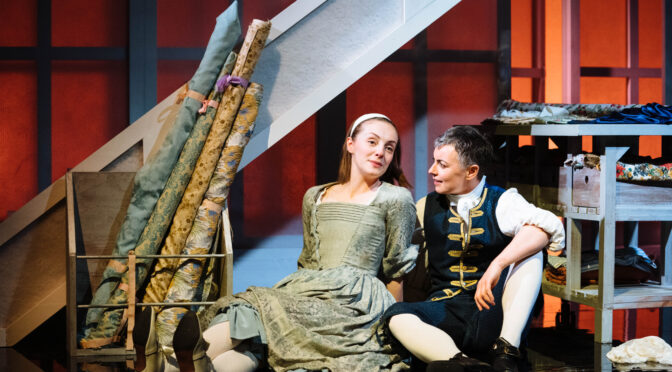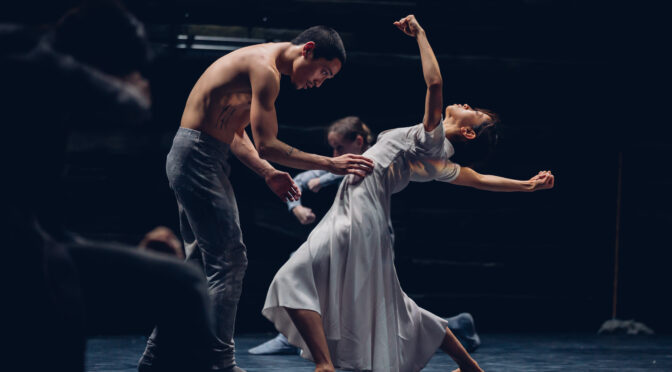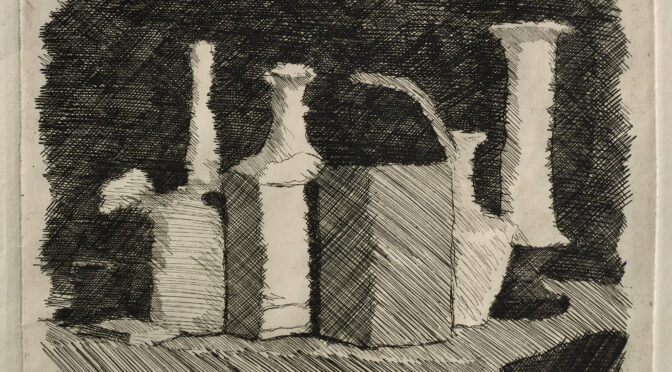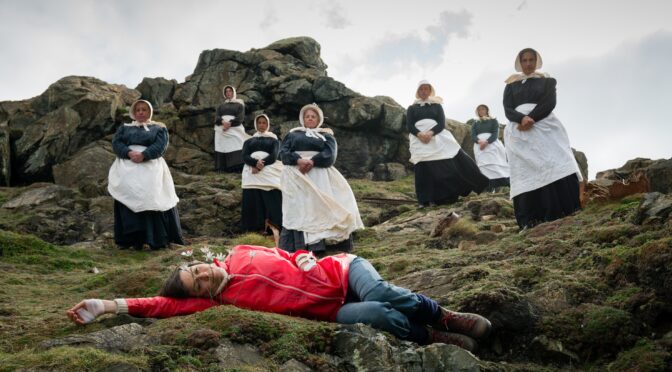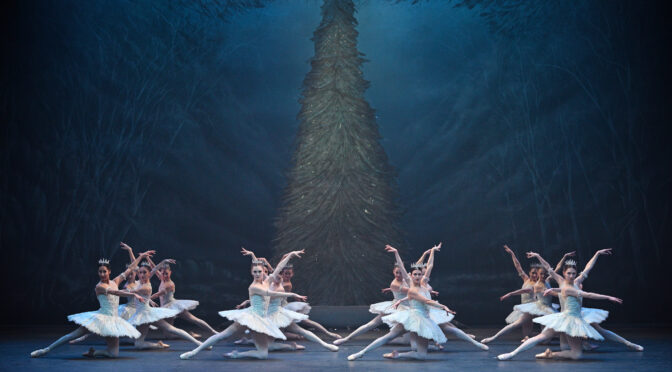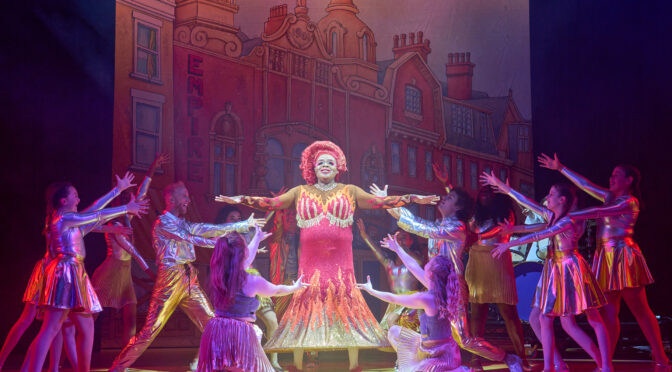A queer historical romance written by a talented new playwright (Ruby Thomas) at a trendy and reputable fringe theatre (Hampstead) – what more could you want? Well, as it turns out, quite a lot more. A clipped, panto-style courtship begins a whimsical romance before a sombre second half severely alters the tone, leaving the audience with a narrative propelled by inevitability and doom. This tragic narrative arc is perhaps an accurate trajectory for a historical exploration of lived queer experience, but, as a piece of theatre, it doesn’t offer up much in the way of cliff-hangers or surprise for the audience, who sense that this can only, unavoidably, end one way. Despite the pitfalls in the narrative structure, the sparkling characters in this play are amusing and memorable, both brave and bawdy and sharp and articulate, Linck & Mülhahn are a power couple we all should know about.
Owen Horsley’s production, set in eighteenth-century Prussia, follows the true story of Anastasius Linck – an individual who, after it is discovered that they were assigned female gender at birth but is presenting as male, is trialled along with their wife, Mülhahn, for illicit sexual relations (and secondarily for desertion as a soldier). Ruby Thomas’s play is based on the real transcript from the trial in 1721. In this document, Linck comments that ‘even if (I am) done away with, those who are like (me will) remain’. Linck’s words are a reminder that queer (and specifically non-binary) people have always existed, even if the law has not recognised these identities as real.
The first half is fun, charming and genuinely funny. The music is notably well-chosen and acts as an effective anachronistic element of the production, giving the historical narrative a contemporary feel. Helena Wilson, playing the rebellious Catharina Mülhahn, stands out with her apparently inextinguishable energy, quirky humour and rebellious nature. Lucy Black as her mother adds brilliant (although melodramatic) humour, whilst the ‘Spinster’, Marty Cruickshank, provides contrasting depth and feeling as the wiser and older Mülhahn, doubling as an omniscient narrator – a device which is interesting similar to the omnipresent Virgina Woolf(s) in the Garrick’s recent Orlando.
Maggie Bain, as Anastasius Linck, is, at first, dashing and charming – a smooth-talker and a charismatic soldier; he is as popular amongst his fellow Prussian troops as he is amongst the women. However, soon enough, Linck’s suave and charm start to appear overly stylised and wooden. What’s more, their energy levels seem to dissipate in the presence of Linck, who falls so intensely in love without an apparently reciprocal level of passion from Linck. Indeed, the love story felt shallow and tongue-in-cheek, as if catching laughs from the audience took precedence over a convincing courtship. For example, Linck’s words of agreement when Mülhahn suddenly suggests marriage, are: “F*** it, let’s do it!”. This comic tone would not have been a problem (quite the opposite) if it had been maintained, but the seriousness of the second half felt unconvincing after such an ironic opening.
This dynamic and fluid first half, with its swiftly executed scenes and entertaining dance vignettes, is followed by a slow-moving second half, largely dominated by the court case. The courtroom scene features arbitrary moments of blaring punk paired with strobe lighting between each witness. Is this a reference to the first half and its mood of fun, rebellion and frivolity, or is it a foreboding reference to danger and a symbol for panic? Whatever its purpose, these brief interludes are a jarring distraction. The previously slick and witty humour seems suddenly to be replaced by irrelevant and simplistic jokes and the verbal sparring changes into slow dialogue. However, the macho humour between the men in the courtroom acts as an effective contrast to the flirtatious and unconventional exchanges between Linck and Mülhahn.
In the final scene, as Linck and Mülhahn speak across the adjoining wall of their prison cells, Linck’s tone becomes self-aggrandizing and overly formal, as if reciting a sermon or political speech. Linck’s final speech before death is not full of distress, as expected, but imbued with a calm stoicism which reflects their martyred sense of purpose in dying for a cause they have lived for their whole life. Linck’s fortitude and apparent acceptance in the face of death seem so superhuman that it leaves the audience detached from the emotion of Linck’s tragic fate.
Linck, literally living as a man in a man’s world all their life, has had to hide their vulnerability and perfect their outward presentation for years, never letting their guard down for fear of being “found out”. In this final scene, it would have been a good moment for another side of Linck to have been revealed: a vulnerable and messy Linck, who doesn’t need to “perform” for the outside world.
The play develops from a romantic period piece to a polemic. Altogether, the two halves feel disjointed in tone and the narrative seems to serve primarily as a vehicle for expressing the play’s philosophical agenda, rather than a fully rounded story in itself. Nonetheless, one does glean a valuable insight into the fascinating, though tragic, biography of Anastasius Linck, and the joy of the first half acts as a glimmer of hope and a touchstone for the queer community, highlighting the progress made but also the continued need for tolerance and understanding.
Image: Helena-Wilson and Maggie Bain in Linck & Mulhahn Credit-Helen Murray
Review by Lucy Evans
Lucy’s passion for the arts began with drawing and painting at a young age and developed later on into a love of landscape painting and a degree in Art History, with a focus on Modernism and gender. Lucy has grown to love literature and acting in particular, and her experiences acting at the Edinburgh Fringe Festival have been formative, convincing her that performance can be an essential tool for communication and connection, as well as of course being a valuable source of entertainment.
Lucy’s latest review here Review: The Oyster Problem – Gustave Flaubert pays the price for his insatiable appetite for champagne and oysters – Jermyn Street Theatre until 4 March – Abundant Art
Maggie Bain (who plays Linck) interviewed by Ham&High

